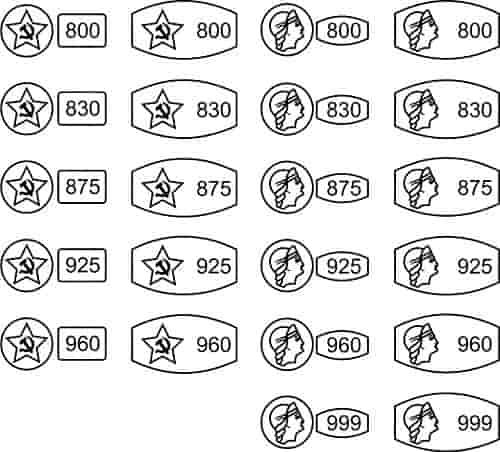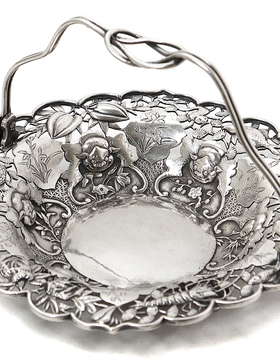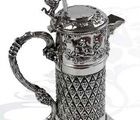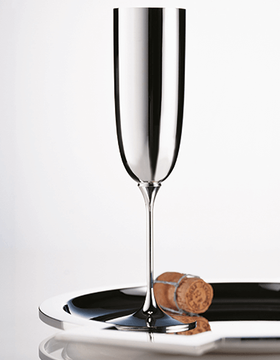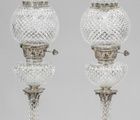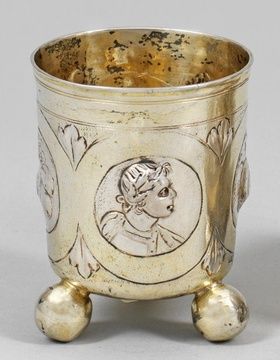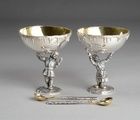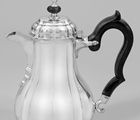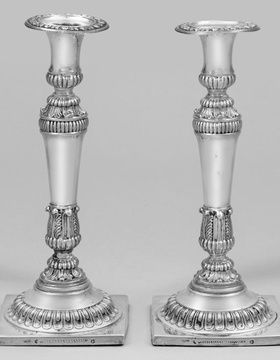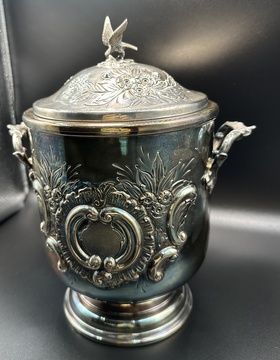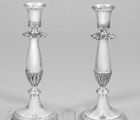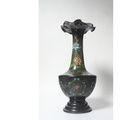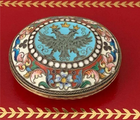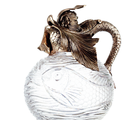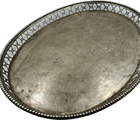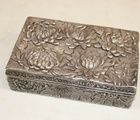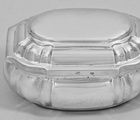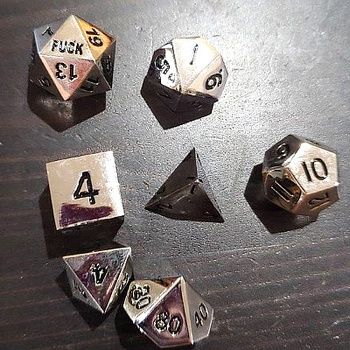
В Европе клеймение ювелирных изделий началось с 13 века, а первые русские клейма появились лишь в 17 веке. Необходимость в контроле качества драгоценных сплавов возникла в связи с тем, что изделия из золота и серебра были потенциальным сырьем для монет, а добыча этих металлов в стране была очень мала, поэтому серебро и золото было в дефиците.
Русские клейма XVII в.
Первый указ о клеймении на Руси датирован 1613 г. Согласно ему, мастера серебряных дел должны были изготавливать изделия из сплава, идентичного европейскому серебряному талеру. Эта монета, получившая название«любский ефимок», содержала до 93 % чистого серебра.
Золотые изделия проверялись на «взрѣзъ» – на мягкость, серебряные «съ пожега» – по изменению цвета при накаливании. Кроме того, использовался пробирный камень. Обязанности испытывать и клеймить изделия возлагались на пробирных мастеров. Клеймо, удостоверяющее надлежащее качество сплава стало называться пробой. Первые клейма, обозначающие пробу, начали ставить в конце 17 века. Пробы, равные ефимку, были в ходу с 1693 по 1697 гг. Они представляют собой круг с буквами «ЄϴЌ».
В 17 веке появился еще один эталон серебряного сплава — голландский левендальдер (львиный талер). Эта монета чеканилась из более низкопробного сплава (до 74 % серебра), и называлась в народе «левок» из-за изображенного на монете льва. Изделия, соответствующие сплаву львиного талера, клеймились до 1698 г. круглыми и овальными клеймами с надписью «левокъ» и «лев».

Кроме пробы, существовали городские клейма с гербами городов. Самые ранние из известных городских клейм (1651 — 52 гг.) – московские клейма в виде щитка с изображением двуглавого орла и даты, обозначенной славянскими буквами. К концу 17 в. относятся клейма городов Дерпт, Митава, Нарва, Ревель, Рига. Также, на изделия вплоть до 1741 г. наносили годовые клейма в виде круга с буквами внутри.
Клеймение после реформы Петра Великого
В 1700 г. в России Петром I начата монетная реформа. В подражание иностранному дукату была отчеканена русская золотая монета – червонец. Далее Кадашевский монетный двор отошел от стандартов дуката. Новая монета содержала 78,1 % чистого золота, ее вес равнялся золотнику (4.26 г). В феврале 1700 г. вышел указ, предписывающий установить клейма для золота и серебра. Клеймение изделий, надзор над мастерами и торговцами возложены на пробирных старост. Пробы были определены приблизительно.
В золоте:
- 1я – «выше червоннаго»;
- 2я – «против червоннаго»;
- 3я, 4я – «ниже червоннаго».
В серебре:
- 1я, 2я – «плавленнаго серебра»;
- 3я – «ефимочная»;
- 4я – «левковая».
В 1711 году пробы на серебре стали устанавливать в цифровом выражении. Третья проба клеймилась цифрами «82». Четвертая – «62», а после 1731 года – «72». Закрепилась золотниковая система: проба равна количеству золотников драгметалла в фунте сплава. Чистое золото и серебро приравнивается к 96 пробе (столько золотников в 1 фунте).
Клеймо с пробой этого периода выполнено в виде цифр, заключенных в прямоугольник. Пуансоны для клеймения изготавливались Монетным двором. Кроме пробы на изделие ставилось городское клеймо, именник ювелира, мастерской или фабрики-изготовителя, клеймо пробирного мастера. Клеймение проводилось в пробирных палатках, основанных в Москве и Петербурге.
Пробирным уставом 1847 г. утверждены пробы:
- в золоте – 56, 72, 82;
- в серебре – 84, 88, 91.
Следующими уставами число проб увеличено. Своеобразным знаком качества изделия в 50-х гг. стало клеймо альдермана – старосты ремесленного цеха.
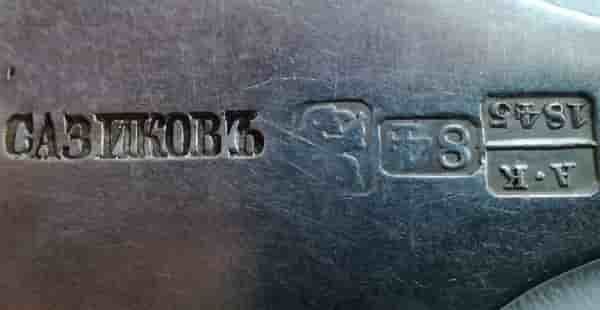
В 1896 г. принят очередной Пробирный устав. Россия разделена на 11 пробирных округов во главе с управляющими. Придворные мастера и фирмы получили разрешение ставить на свои изделия оттиск клейма с государственным гербом. Во 2.п. 19 в. проба часто размещалась в одном щитке с клеймом города, или в щитке с инициалами пробирного мастера.
С 1899 г. утверждено единое клеймо с контурным изображением обращенного влево женского профиля в кокошнике. В 1908 г. введено клеймо с рельефным женским профилем, обращенным вправо. Шифр окружного пробирного учреждения проставляется греческой буквой.
Пробы и клейма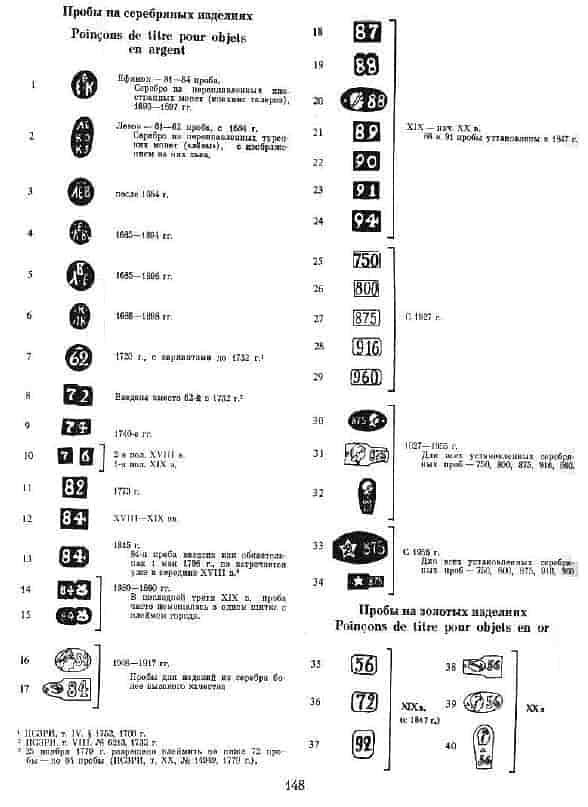
Клеймение ювелирных изделий в эпоху СССР
В 1927 г. золотниковая система заменена на метрическую. Проба стала определяться количеством граммов драгметалла в килограмме сплава. В СССР для изделий ювелирной промышленности устанавливаются пробы:
- золото – 958, 750, 583, 500, 375;
- серебро – 960, 916, 875, 800, 750;
- платина – 950;
- палладий – 850, 500.
Организованы государственные пробирные инспекции, выполняющие функции пробирования и клеймения. Пробирные клейма до 1958 г. представлены профилем головы рабочего с молотом в щитке в виде лопатки, овала, усеченного овала или молотка. Сопровождаются цифровой пробой и буквой греческого алфавита – шифром пробирного учреждения. Позднее, изображение рабочего заменено на серп с молотом в пятиконечной звезде. Изделия, не соответствующие заявленной пробе, клеймятся буквами «НП».
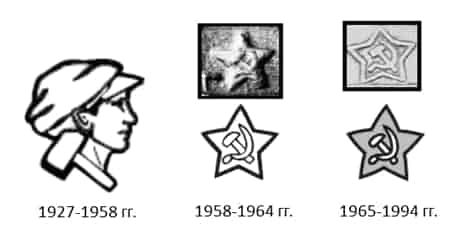
Все изделия в пробирные инспекции должны были поступать с именником предприятия-изготовителя. Для проведения анализа сплавов используются способы:
- натир на пробирном камне
- муфельный метод
После распада СССР в 1994 г. советская эмблема на российском пробирном клейме заменена на женский профиль в кокошнике, смотрящий вправо. Введена 585 проба вместо 583. Лазерное клеймение стало применяться наряду с ударным.
